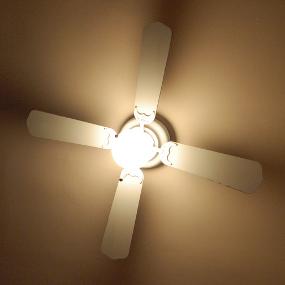Build it Back Greenbushfires
Ceiling Fans
 Mechanical
cooling isn't a substitute for good passive design, but when you've
exhausted your design pallet a cooling fan can make the difference
between loving summers and loathing them. Ceiling fans should be
the first choice over evaporative coolers and air conditioners, for
reasons of energy efficiency and cost savings.
Mechanical
cooling isn't a substitute for good passive design, but when you've
exhausted your design pallet a cooling fan can make the difference
between loving summers and loathing them. Ceiling fans should be
the first choice over evaporative coolers and air conditioners, for
reasons of energy efficiency and cost savings.
The basic principle behind ceiling fans is that they push air around. In summer, a "chill factor" is created as air moves past our skin and evaporates the perspiration on its surface. According to the Your Home Technical Manual, air movement is the most important element of passive cooling.
Consumers keen to conserve energy need to weigh the airflow, measured in revolutions-per-minute (RPM) against the wattage generated to keep those blades circulating. The material that blades are made from - typically timber, moulded plastic or a metal such as stainless steel - affects both airflow and energy consumption, as does the angle and design of the blade. A good rule of thumb is to remember that ornate and overly decorative blades move less air and generally will be less efficient.
Decisions about which blade material to choose will depend on where you plan to put the fan. Powder-coated steel in a coastal location will corrode, whether indoors or outdoors - use timber, ABS plastic, marine grade stainless steel or aluminium instead.
In general, metal blades produce a higher airflow than timber blades, because they have a steep 22 degree pitch (compared to timber blades which usually have a 12 degree pitch). But metal fans use more power than timber, because the steeper the pitch, the more energy it takes to move air. They can also make an audible "whirring" sound, though this is unlikely in quality models.
Metal blades are slim (approx 1mm thick, compared to a 4 to 5mm timber blade) which means they can cut skin if it comes into contact with a moving fan, so you may want to avoid putting them into children's rooms. There are now a range of moulded plastic blades with that same 22 degree pitch.
Ceiling fans can also be used in winter, especially in large rooms with high ceilings. By switching them into reverse mode the fans draws air from the middle of the room and circulates it back down the walls and across the floor, shifting warm air that has accumulated near the ceiling back down to floor level, warming you up from the feet, instead of dumping air directly back down onto you as a regular cycle does.
Suppliers
Spinifex Fans - www.spinifexfans.com.au
Ph. 1300 935 285
G warehouse - www.gwarehouse.com.au
Ph. 02 6581 2411
Hunter Pacific - www.hunterpacific.com.au
Ph. 03 8339 0985
Martec - www.martecceilingfans.com.au
Ph. 02 8778 7500
- More Info
- > resourceSmart - Cooling
- > Your Home - Cooling
Listed suppliers are a guide and are not endorsed by Green Cross Australia or the Alternative Technology Association.
Latest images
flickrLatest videos

Andrew Ash, Director of CSIRO's Climate Adaptation Flagship talks to Mara Bun, CEO of Green Cross Australia about the severe heat climate models and community and infrastructure risk.

Llewellyn is the insipiration behind Conscious Homes, a HIA "GreenSmart award" winning building advisory group based in Eltham. Llewellyn's studio home is a showcase of sustainability.


